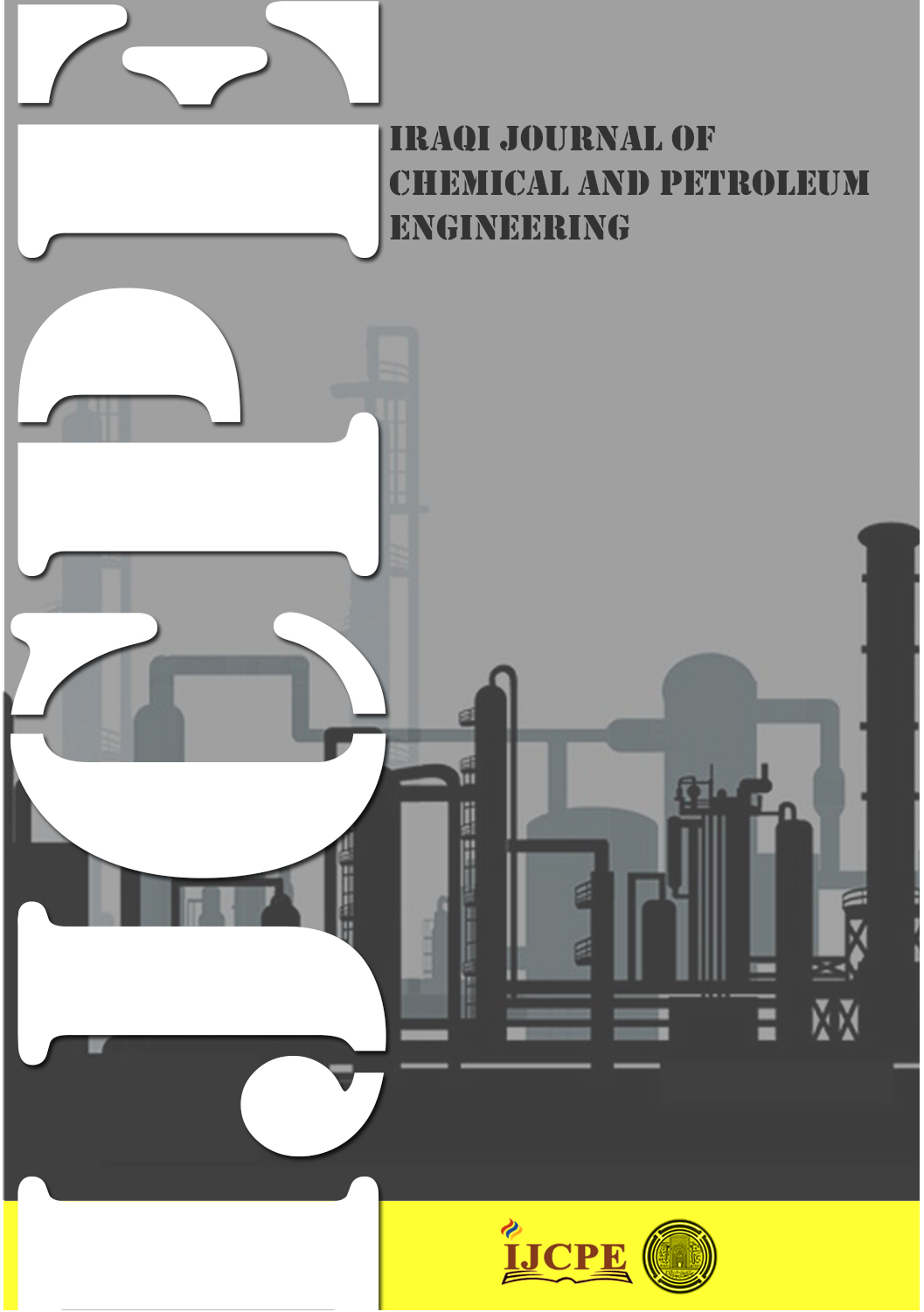Boosting catalytic performance in ZSM-5 (50) catalyst cracking: microwave and Taguchi method with nitrogen activation
DOI:
https://doi.org/10.31699/IJCPE.2025.1.1Keywords:
Microwave reactor; Catalytic cracking; Heavy naphtha cracking; Microwave heterogeneous catalysisAbstract
Microwave power has a more significant effect on cracking with less energy consumption. The microwave power and the catalysis increase the racking rate and the conversion at lower temperatures. Accordingly, the generated hot spots in the catalyst offer a suitable condition for cracking (high rate and low temperature). The microwave technique was used to conduct the cracking of heavy naphtha. A set of experiments was done with microwave power (750–1250 W), preheating temperatures (150–250 ˚C), and space velocities (2–6 l/hr) with and without nitrogen injection. The nitrogen injection enhanced the conversion for all situations. The best result has a conversion of 47.37% with nitrogen injection at microwave power of 1250 W, a flow rate of 4 l/hr, and a preheating temperature of 250˚C. Generally, it was noted that the flow rate did not affect the conversion. Compared to conventional techniques, the microwave power increased both the reaction and conversion rates, allowing for work at lower temperatures that traditional methods cannot achieve. This study investigated how microwaves with catalysts affect residence time, energy savings, and conversion. The microwave technique experiment could be scaled up to become a mass production unit in any refinery.
Received on 21/09/2024
Received in Revised Form on 06/11/2024
Accepted on 08/11/2024
Published on 30/03/2025
References
[1] A. N. Hammadi and I. K. Shakir, “Enhancement the octane number of light naphtha by adsorption process,” AIP Conference Proceedings, vol. 2213, no. March, 2020, https://doi.org/10.1063/5.0000129
[2] N. M. Abdullah, H. Q. Hussien, and R. R. Jalil, “Heavy Naphtha Desulfurization by Ozone Generated via the DBD Plasma Reactor,” Iraqi Journal of Chemical and Petroleum Engineering , vol. 25, no. 2, pp. 131–137, 2024, https://doi.org/10.31699/IJCPE.2024.2.12
[3] S. Seifzadeh Haghighi, M. R. Rahimpour, S. Raeissi, and O. Dehghani, “Investigation of ethylene production in naphtha thermal cracking plant in presence of steam and carbon dioxide,” Chemical Engineering Journal, vol. 228, pp. 1158–1167, 2013, https://doi.org/10.1016/j.cej.2013.05.048
[4] G. J. Antos and A. M. Aitani, “Catalytic Naphtha Reforming Revised and Expanded”, Environmental Chemistry Letters, vol. 01. p. 507-522, 2004, https://doi.org/10.1201/9780203913505
[5] V. H. Da Silva, M. V. Reboucas, A. R. Salles, M. F. Pimentel, M. J. C. Pontes, and C. Pasquini, “Determination of naphtha composition by near infrared spectroscopy and multivariate regression to control steam cracker processes,” Fuel Processing Technology, vol. 131, pp. 230–237, 2015, https://doi.org/10.1016/j.fuproc.2014.10.035
[6] A. H. A.K. Mohammed, S. Karim, and A. M. Rahman, “Characterization and Cracking Activity of Zeolite Prepared from Local Kaolin,” Iraqi Journal of Chemical and Petroleum Engineering , vol. 11, no. 2, pp. 35–42, 2010, https://doi.org/10.31699/IJCPE.2010.2.4
[7] M. F. Abd, A. M. Al-yaqoobi, and W. S. Abdul-Majeed, “Catalytic Microwave Pyrolysis of Albizia Branches Using Iraqi Bentonite Clays,” Iraqi Journal of Chemical and Petroleum Engineering , vol. 25, no. 2, pp. 175–186, 2024, https://doi.org/10.31699/IJCPE.2024.2.16
[8] N. S. Majeed and J. T. Majeed, “Study the Performance of Nanozeolite NaA on CO2 Gas Uptake,” Iraqi Journal of Chemical and Petroleum Engineering , vol. 18, no. 2, pp. 57–67, 2017, https://doi.org/10.31699/IJCPE.2017.2.5
[9] S. M. Al-Jubouri, H. A. Al-Jendeel, S. A. Rashid, and S. Al-Batty, “Green synthesis of porous carbon cross-linked Y zeolite nanocrystals material and its performance for adsorptive removal of a methyl violet dye from water,” Microporous and Mesoporous Material, vol. 356, p. 112587, 2023, https://doi.org/10.1016/j.micromeso.2023.112587
[10] A. García, C. M. López, L. V. García, J. Casanova, and M. R. Goldwasser, “Improvements in the synthesis of zeolites with low Si / Al ratio from Venezuelan sodium silicate for an environmentally friendly process Mejoras en la síntesis de zeolitas con baja relación Si / Al,” Ingenieria e Investigación, vol. 36(1), pp. 62–69, 2016, http://dx.doi.org/10.15446/ing.investig.v36n1.52855
[11] M. A. Theyab, B. M. I. Al-Hilali, D. T. Fadhil, and O. S. Dahham, “Zeolite Effective Use in Treatment of Physical and Chemical Properties of Sewage Water Discharged from General Samarra Hospital,” AIP Conference Proceedings, vol. 2660, no. November, 2022, https://doi.org/10.1063/5.0108004
[12] R. Khoshbin and R. Karimzadeh, “Synthesis of mesoporous ZSM-5 from rice husk ash with ultrasound assisted alkali-treatment method used in catalytic cracking of light naphtha,” Advanced Powder Technology, vol. 28, May 2017, https://doi.org/10.1016/j.apt.2017.04.024
[13] N. Rane, M. Kersbulck, R. A. van Santen, and E. J. M. Hensen, “Cracking of n-heptane over Brønsted acid sites and Lewis acid Ga sites in ZSM-5 zeolite,” Microporous and Mesoporous Materials, vol. 110, no. 2, pp. 279–291, 2008, https://doi.org/10.1016/j.micromeso.2007.06.014
[14] S. A. M. Mohammed and M. S. Mohammed, “The Application of Microwave Technology in Demulsification of Water-in-Oil Emulsion for Missan Oil Fields,” Iraqi Journal of Chemical and Petroleum Engineering , vol. 14, no. 2, pp. 21–27, 2013, https://doi.org/10.31699/IJCPE.2013.2.4
[15] M. Abd and A. Al-yaqoobi, “The feasibility of utilizing microwave-assisted pyrolysis for Albizia branches biomass conversion into biofuel productions,” International Journal of Renewable Energy Development, vol. 12, Oct. 2023, https://doi.org/10.14710/ijred.2023.56907
[16] W. Wang et al., “Quantitative measurement of energy utilization efficiency and study of influence factors in typical microwave heating process,” Energy, vol. 87, pp. 678–685, 2015, http://dx.doi.org/10.1016/j.energy.2015.05.036
[17] M. Mozafari and Z. Nasri, “Operational conditions effects on Iranian heavy oil upgrading using microwave irradiation,” Journal of Petroleum Science and Engineering, vol. 151, no. December 2016, pp. 40–48, 2017, https://doi.org/10.1016/j.petrol.2017.01.028
[18] M. B. Gawande, S. N. Shelke, R. Zboril, and R. S. Varma, “Microwave-Assisted Chemistry: Synthetic Applications for Rapid Assembly of Nanomaterials and Organics,” Accounts of Chemical Research, vol. 47, no. 4, pp. 1338–1348, Apr. 2014, https://doi.org/10.1021/ar400309b
[19] A. Hoz, A. Díaz-Ortiz, and A. Moreno, “Microwaves in Organic Synthesis. Thermal and Non-Thermal Microwave Effects,” Chemcal Society Reviews, vol. 34, pp. 164–178, Mar. 2005, https://doi.org/10.1039/B411438H
[20] A. Corma, J. Mengual, and P. J. Miguel, “Steam catalytic cracking of naphtha over ZSM-5 zeolite for production of propene and ethene: Micro and macroscopic implications of the presence of steam,” Applied Catalysis A: General, vol. 417–418, pp. 220–235, 2012, https://doi.org/10.1016/j.apcata.2011.12.044
[21] M. Mora, M. del Carmen García, C. Jiménez-Sanchidrián, and F. J. Romero-Salguero, “Transformation of light paraffins in a microwave-induced plasma-based reactor at reduced pressure,” International Journal of Hydrogen Energy, vol. 35, no. 9, pp. 4111–4122, 2010, https://doi.org/10.1016/j.ijhydene.2010.01.149
Downloads
Published
Issue
Section
License
Copyright (c) 2025 The Author(s). Published by College of Engineering, University of Baghdad.

This work is licensed under a Creative Commons Attribution 4.0 International License.













